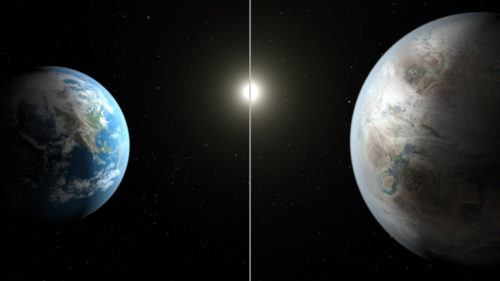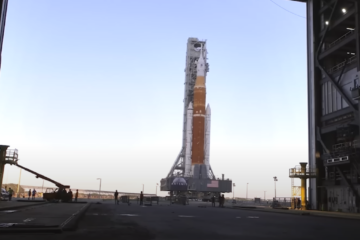Bigger, Older Cousin of Earth Discovered
And where are our efforts and resources going today: To spread our race to new habitable worlds? — or feeding and protecting worthless parasites, and rushing heedless toward our doom?
NASA’s KEPLER mission has confirmed the first near-Earth-size planet in the “habitable zone” around a sun-like star. This discovery and the introduction of 11 other new small habitable zone candidate planets mark another milestone in the journey to finding another “Earth.” (ILLUSTRATION: This artist’s concept compares Earth (left) to the new planet, called Kepler-452b, which is about 60 percent larger in diameter.)
The newly discovered Kepler-452b is the smallest planet to date discovered orbiting in the habitable zone — the area around a star where liquid water could pool on the surface of an orbiting planet — of a G2-type star, like our sun. The confirmation of Kepler-452b brings the total number of confirmed planets to 1,030.
“On the 20th anniversary year of the discovery that proved other suns host planets, the Kepler exoplanet explorer has discovered a planet and star which most closely resemble the Earth and our Sun,” said John Grunsfeld, associate administrator of NASA’s Science Mission Directorate at the agency’s headquarters in Washington. “This exciting result brings us one step closer to finding an Earth 2.0.”
Kepler-452b is 60 percent larger in diameter than Earth and is considered a super-Earth-size planet. While its mass and composition are not yet determined, previous research suggests that planets the size of Kepler-452b have a good chance of being rocky.
While Kepler-452b is larger than Earth, its 385-day orbit is only 5 percent longer. The planet is 5 percent farther from its parent star Kepler-452 than Earth is from the Sun. Kepler-452 is 6 billion years old, 1.5 billion years older than our sun, has the same temperature, and is 20 percent brighter and has a diameter 10 percent larger.
“We can think of Kepler-452b as an older, bigger cousin to Earth, providing an opportunity to understand and reflect upon Earth’s evolving environment,” said Jon Jenkins, Kepler data analysis lead at NASA’s Ames Research Center in Moffett Field, California, who led the team that discovered Kepler-452b. “It’s awe-inspiring to consider that this planet has spent 6 billion years in the habitable zone of its star; longer than Earth. That’s substantial opportunity for life to arise, should all the necessary ingredients and conditions for life exist on this planet.”
To help confirm the finding and better determine the properties of the Kepler-452 system, the team conducted ground-based observations at the University of Texas at Austin’s McDonald Observatory, the Fred Lawrence Whipple Observatory on Mt. Hopkins, Arizona, and the W. M. Keck Observatory atop Mauna Kea in Hawaii. These measurements were key for the researchers to confirm the planetary nature of Kepler-452b, to refine the size and brightness of its host star and to better pin down the size of the planet and its orbit.
The Kepler-452 system is located 1,400 light-years away in the constellation Cygnus. The research paper reporting this finding has been accepted for publication in The Astronomical Journal.
In addition to confirming Kepler-452b, the Kepler team has increased the number of new exoplanet candidates by 521 from their analysis of observations conducted from May 2009 to May 2013, raising the number of planet candidates detected by the Kepler mission to 4,696. Candidates require follow-up observations and analysis to verify they are actual planets.
Twelve of the new planet candidates have diameters between one to two times that of Earth, and orbit in their star’s habitable zone. Of these, nine orbit stars that are similar to our sun in size and temperature.
“We’ve been able to fully automate our process of identifying planet candidates, which means we can finally assess every transit signal in the entire Kepler dataset quickly and uniformly,” said Jeff Coughlin, Kepler scientist at the SETI Institute in Mountain View, California, who led the analysis of a new candidate catalog. “This gives astronomers a statistically sound population of planet candidates to accurately determine the number of small, possibly rocky planets like Earth in our Milky Way galaxy.”
These findings, presented in the seventh Kepler Candidate Catalog, will be submitted for publication in the Astrophysical Journal.
Scientists now are producing the last catalog based on the original Kepler mission’s four-year data set. The final analysis will be conducted using sophisticated software that is increasingly sensitive to the tiny telltale signatures of Earth-size planets.
And, according to SevenArticle.com:
Nasa scientists have announced the discovery of Kepler 452b, also known as ‘Earth 2.0’, an earth-like planet in our galaxy.
Over the course of years of data-gathering by the Kepler space telescope and even more analysis and work here on Earth, scientists confirmed the existence of the distant exoplanet, which is the most earth-like planet ever discovered.
Although the planet is far too far away to photograph, advanced Nasa technology means we know a surprising amount about this ‘New Earth’.
Beginning the conference, John Grunsfeld, associate administrator for Nasa’s Science Mission Directorate in Washington, said: “Today we’re announcing the discovery of an exoplanet that as far as we can tell is a pretty close cousin of Earth. It’s the closest so far. It’s Earth 2.0.”
Everything about Kepler 452b — from its size, the length of its years, the estimated conditions on the surface — is very similar to Earth.
Years on Kepler 452b are about the same duration as they are on Earth:
A year on the newly-discovered planet — the time it takes to orbit its star, Kepler 452 — lasts for 385 days, only 20 days longer than a year here on Earth.
That’s much different to years on other, closer planets to Earth. A year on Venus, sometimes the closest planet to the Earth, lasts only 88 Earth-days. A year on Neptune, further out in our solar system, is the equivalent of 185 Earth-years.
It’s spent billions of years within the optimal habitable distance of its star:
Kepler 452, the planet’s star, is around 1.5 billion years older than our Sun. If a planet is too close to its star, it will be too hot to host life. If it’s too far away, it will be too cold.
Kepler 452b has been the perfect distance from its star for many billions of years. According to Jon Jenkins, the Kepler data analysis lead at NASA’s Ames Research Centre, this means it’s possible that it hosts life on its surface, or at least could have at some point in its history.
It could have active volcanoes and water on its surface:
Kepler 452b is possibly the right temperature to allow liquid water to exist on the surface — as far as we know, this is essential for supporting life.
According to John Coughlin, a researcher at the SETI Institute in California, the Kepler team worked with geologists to find out the make-up of the planet. Due to its size and age, it’s likely that it is a rocky planet, meaning it could have a volcanic system under its surface.
Humans could potentially survive in Kepler 452b’s stronger gravity:
The new planet is slightly larger than Earth, and is estimated to have twice the gravitational pull of our own planet. However, according to the scientists on the Kepler team, this doesn’t mean it couldn’t support life.
Jon Jenkins said that humans could “adapt” to the gravity, possibly becoming “more stocky over many generations.”
“People already adapt to heavy weights — humans are built to do this kind of thing. The human body has an amazing ability to repair itself — so over time, humans could adapt.”
Plants could potentially thrive there:
The planet’s star, Kepler 452, is slightly bigger than our own Sun. The added light and heat energy that the planet receives from the star not only means it is slightly warmer than Earth, but could also mean that plant life could thrive there.
And since plant photosynthesis is what produces the air we breathe, that means this essential building block of life has a good chance of living on Kepler 452b.
Jon Jenkins told the press conference: “The sunshine from Kepler’s star is very similar to sunshine from our own star, and plants could be able to photosynthesise just the same.”
“It would feel a lot like home.”
You could even get a tan there:
Dr Daniel Brown, an astronomy expert at Nottingham Trent University, said: “Kepler 452b receives the same kind of spectrum and intensity of light as we do on Earth. This means plants from our planet could grow there if it were rocky and had an atmosphere. You could even get a healthy tan like here on holiday.”
Much more research on the planet is still being done, which will be able to confirm whether anything could thrive on Kepler 452b.
Unfortunately, it’s pretty much impossible to get there (at the moment):
Kepler 452b is warm, possibly wet, and might be able to host plant life — however, it’s 1,400 lightyears away.
A lightyear is the distance that a beam of light can travel in a year. Light travels at over 670 million miles per hour. Light from the Sun takes around eight minutes to reach Earth, so naturally, a trip to Kepler 452b would take an incredibly long time.
Nasa’s New Horizon probe — the one that recently took the amazing pictures of Pluto — left Earth’s orbit faster than any other spacecraft before it, at around 36,373mph.
If a spacecraft carrying humans travelled at this speed towards Kepler 452b, it would take the unlucky astronauts around 25.8 million years to get there. To put that in perspective, early, primitive humans only evolved around 2.5 million years ago.
* * *
Source: Science Daily







“feeding and protecting worthless parasites” also lowering our educational standards to accommodate said parasites so we’ll never realize our potential.
Archer, to an extent I agree with you. The future awaits us to educate ourselves and our descendants outside the system’s reach (at this time) and we’re free to do so. Look at the homeschooling “movement”, it shows us that many are reacting to the lowered standards among other reasons.
I believe it remains to us Whites to form our own communities (within larger heterogenous communities if necessary) and work towards building new educational institutions for our (White) use only. Imagine, if you will, a Cosmotheist community church based college for instructing the future instructors of our adults and our young…
I am in Eastern TN and have already built a permaculture food supply over the last two year. Also doing small organic farming to feed myself and a few other. We are energy independent, with solar and water. It is very easy for any white even today to get off the grid and live healthy, the only problem for most is lack of know how and not having a community to move into. You have to build it and then other like minded people will come, be careful who you invite in. I already have 5 families who built homes and started mini organic farms around me, after i went out a told others with the same beliefs and drive. They are working on other projects at the same time.… Read more »